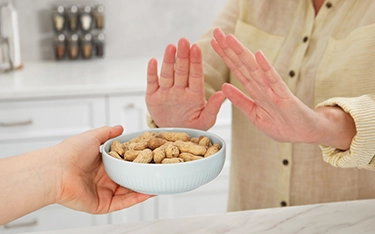A peanut allergy is more than just an inconvenience, it can be life-changing. From carefully scanning food labels to managing fear of accidental exposure, living with a peanut allergy requires constant awareness and support.
A case study published in Dr Batra’s® Coffee Table Book, Volume 2 highlights a fitness enthusiast who faced allergic reactions to almonds, raisins, oats, and peanuts, an unusual challenge given their role in a healthy diet. Instead of eliminating these nutrient-rich foods, personalised homeopathic treatment helped desensitise the body to these allergens. Over time, the patient experienced a significant reduction in allergic episodes and is now allergy-free.
In India, peanut allergies are increasing, especially among children. A recent ICMR-backed study found that food allergies now affect nearly 2% of Indian children, with peanuts being one of the most common culprits. Unlike mild intolerances, peanut allergies can trigger severe and even life-threatening reactions. But with the right management plan, supportive care, and natural treatment options, it is possible to live confidently and safely.
Peanut allergies are triggered by your immune system overreacting. Strengthening the immune response and maintaining a calm gut environment can significantly reduce sensitivity over time.
Decoding Peanut Allergies: What You Should Know
A peanut allergy occurs when the body mistakenly identifies peanut proteins as harmful. This overreaction triggers the release of histamines and other chemicals, causing symptoms ranging from mild to severe.
Common Signs of Peanut Allergy:
Skin-Level Symptoms
- Hives, redness, or itching around the mouth or skin
- Swelling of the lips, face, or eyelids
Gastrointestinal Symptoms
- Stomach cramps
- Vomiting
- Diarrhoea
Respiratory Symptoms
- Shortness of breath or wheezing
- Swelling of the tongue or throat
- Sudden drop in blood pressure (in severe cases – anaphylaxis)
Most symptoms occur within minutes of exposure. Early recognition and timely response are critical.
What Triggers It?
- Eating foods containing even trace amounts of peanuts
- Cross-contamination in packaged or restaurant foods
- Inhalation of peanut dust or aerosolised oil (rare but possible)
- Skin contact in sensitive individuals
Dr Batra’s® pro tip:
Peanut allergies are triggered by your immune system overreacting. Strengthening the immune response and maintaining a calm gut environment can significantly reduce sensitivity over time.
Everyday Challenges of Living with a Peanut Allergy
Living with a peanut allergy goes beyond avoiding certain foods, it shapes how one interacts socially, eats outside, or even travels.
- Fear of accidental exposure at restaurants, parties, or schools
- Constant label-reading and menu scanning
- Anxiety about cross-contamination in kitchens
- Emotional stress in children who feel “different” from peers
- Limited access to allergy-aware food options in India
- Carrying emergency medication such as antihistamines or epinephrine auto-injectors (EpiPen)
Managing this allergy is about avoiding it and creating a safe mental and physical lifestyle.
Home Remedy for Peanut Allergy: What Helps, What Does Not
There is no proper “cure” for peanut allergies at home. However, specific remedies can help manage mild symptoms or support the immune system over time.
Safe Supportive Remedies:
- Probiotics: Help maintain gut balance, which can reduce allergic reactions over time
- Vitamin C: Natural antihistamine that may reduce reaction severity
- Turmeric: Anti-inflammatory, may soothe mild swelling and gut irritation
- Cold compress: Can reduce skin itching or hives after accidental contact
Important: No home remedy for peanut allergy can replace emergency care. A doctor must treat severe symptoms.
Homeopathy for Peanut Allergies – A Natural Approach
Homeopathy aims to reduce immune hypersensitivity over time by balancing the body’s reaction to triggers. It is gentle, non-steroidal, and suitable for children and adults alike.
How Homeopathy Helps:
- Regulates overactive immune responses
- Reduces the recurrence of allergic symptoms
- Addresses associated anxiety, digestive issues, or skin problems
- Strengthens gut health and immune tolerance gradually
- Customised remedies based on allergy severity, emotional stress, and overall constitution
This approach is not an immediate fix but offers long-term, side-effect-free support.


